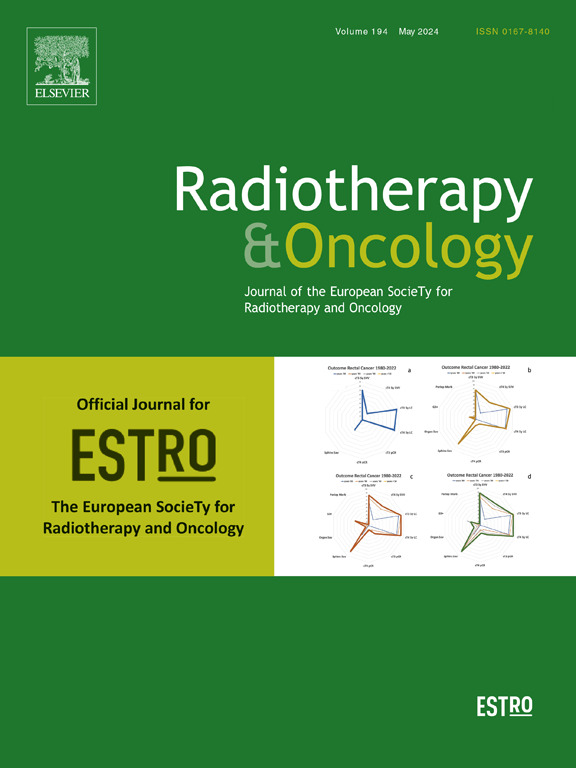低分缩加速放射剂量喷涂(HARD)可改善未切除软组织肉瘤的治疗效果。
IF 4.9
1区 医学
Q1 ONCOLOGY
引用次数: 0
摘要
软组织肉瘤(STS)具有放射性耐药性,α/β值较低,低剂量治疗可能会带来生物益处。对于无法切除的STS,为达到持久控制所需的剂量升级往往受到长期毒性风险的限制。我们试图比较利用低分次加速放射剂量喷涂(HARD)与标准分次放射治疗(SFT)的等毒方法对无法切除的 STS 患者的治疗效果。我们对 1990 年至 2022 年间接受过 HARD(49 人)或 SFT(43 人)光子疗法的未切除 STS 患者进行了回顾性分析。根据疾病负担的风险,2 种 HARD 方案各使用 3 个剂量等级。重大疾病、中度风险和低度风险临床靶体积采用 20-22 次 3/2.5/2-2.2 Gy 或 28 次 2.5/2.2/1.8 Gy 治疗。SFT包括以确定性意图接受治疗的患者,每分次接受≥ 50 Gy,每次1.8-2 Gy。临床终点包括3年局部控制(LC)、总生存期(OS)和无进展生存期(PFS)以及治疗相关毒性。中位年龄为 67 岁,肿瘤大小为 7 厘米,大多数患者为 IV 期(37%)、3 级(67%)、未同时接受全身治疗(70%)和下肢肿瘤(24%)。HARD 队列中年龄、分期、复发疾病和中位 BED4 均较高(P<0.05)。本文章由计算机程序翻译,如有差异,请以英文原文为准。
Hypofractionated accelerated radiation dose-painting (HARD) improves outcomes in unresected soft-tissue sarcoma
Soft tissue sarcomas (STS) are radioresistant with a low α/β, which may have a biologic benefit with hypofractionation. For unresectable STS, the dose escalation required to achieve durable control is often limited by long-term toxicity risk. We sought to compare an isotoxic approach utilizing hypofractionated accelerated radiation dose-painting (HARD) versus standard fractionated radiation therapy (SFT) in patients with unresected STS.
We conducted a retrospective analysis of patients with unresected STS who received either HARD (n = 49) or SFT (n = 43) with photon-based therapy between 1990 and 2022. The 2 HARD regimens each use 3 dose levels based on risk of disease burden. The gross disease, intermediate risk, and low-risk clinical target volumes were treated with either 20–22 fractions of 3/2.5/2–2.2 Gy or 28 fractions of 2.5/2.2/1.8 Gy. SFT included patients treated with definitive intent, receiving ≥ 50 Gy in 1.8–2 Gy per fraction. Clinical endpoints included 3-year local control (LC), overall survival (OS), and progression-free survival (PFS), along with treatment-related toxicity.
With a median age of 67 and tumor size of 7 cm, most patients were stage IV (37 %), grade 3 (67 %), had no concurrent systemic therapy (70 %), and were lower extremity tumors (24 %). HARD cohort consisted of higher age, stage, recurrent disease, and median BED4 (p < 0.05), when compared to SFT. With a median follow-up of 35.9 months, HARD demonstrated significant improvement in 3-year LC (96.4 % vs. 48.4 %, p < 0.001), compared to SFT overall, with a median PFS benefit (16 vs. 10 months, p = 0.037) for non-distantly metastatic patients at baseline. On multivariate analysis, HARD was significantly associated with improved LC (HR 0.058, 95 % CI 0.005–0.682, p = 0.024). The HARD regimen found no significant increase in toxicity, with limited acute grade 3 (24 %, all dermatitis) and late grade 3 toxicity (6 %) observed, with no grade 4 or 5 events.
HARD regimen significantly improves LC for unresectable STS without a significant increase in toxicity, when compared to a standard fractionated approach, supporting further prospective investigation of this treatment approach.
求助全文
通过发布文献求助,成功后即可免费获取论文全文。
去求助
来源期刊

Radiotherapy and Oncology
医学-核医学
CiteScore
10.30
自引率
10.50%
发文量
2445
审稿时长
45 days
期刊介绍:
Radiotherapy and Oncology publishes papers describing original research as well as review articles. It covers areas of interest relating to radiation oncology. This includes: clinical radiotherapy, combined modality treatment, translational studies, epidemiological outcomes, imaging, dosimetry, and radiation therapy planning, experimental work in radiobiology, chemobiology, hyperthermia and tumour biology, as well as data science in radiation oncology and physics aspects relevant to oncology.Papers on more general aspects of interest to the radiation oncologist including chemotherapy, surgery and immunology are also published.
 求助内容:
求助内容: 应助结果提醒方式:
应助结果提醒方式:


